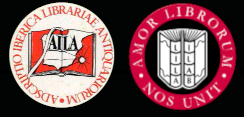


Home |
Temáticas |
Catálogos |
Pedidos |
  |  |
|||||||
|

|
RUGENDAS. (Johann Moritz) HABITANTE DE GOYAS, QUADRO A ÓLEO PINTADO SOBRE MADEIRA. |
|
|
Clique nas imagens para aumentar. PORTUGAL, Amélie de [S. M. la Reine, Princesse de France] MES DESSINS. MES ENDROITS PRÉFÉRÉS. / ART ET ARCHEOLOGIE. – Edition de Luxe.1º VOLUME: MES DESSINS (Os meus Desenhos). MES ENDROITS PRÉFÉRÉS (Os meus Logares predilectos). Le Goupy, Éditeur. Paris. 1926. In fólio (41x28 cm) com [8], 119, [12] fólios. JUNTO COM O 2º VOLUME: MES DESSINS (Os meus Desenhos) II. [Deuxième Sèrie]: ART ET ARCHÉOLOGIE (Arte e Archeologia). MAGGS BROS., Libraires de Sa Magesté le Roi d’Angleterre […] Londres, 1928. In fólio (41x28 cm) com [8], 100, [6], [1br] fólios. Esta obra, publicada em duas séries sucessivas (1927 e 1928), contém as reproduções a cores dos desenhos originais da Rainha D. Amélia. Os dividendos obtidos com a venda reverteram para caridade. O preço de cada uma das 250 cópias da segunda série era de 1.000 Francos Franceses e as 25 cópias da Edição de Luxo, assinadas pela Rainha, foram vendidas a 1.500 francos franceses por exemplar. A Maggs Bros. enviou uma nota de editor internacionalmente (incluída nesta cópia), esperando que a procura desta segunda série fosse bastante elevada, o que de facto aconteceu. As capas do editor, que contêm estas duas séries de desenhos, são em pergaminho natural com dois atilhos em pele que fecham abotoados com pequenas bolinhas em marfim (em falta nestes exemplares). Apresentam as pastas anteriores com esquadrias com o monograma “MA” de Maria Amélia nos cantos e super-libris com a coroa real no 1º volume e as armas reais juntas dos Braganças e dos Orleães no 2º volume. DESCRIÇÃO DOS VOLUMES: 1º VOLUME Exemplar nº 96 de uma única tiragem de 250 exemplares. Encadernação-pasta do editor, em pergaminho rígido contendo folios soltos. Impressão sobre papel de linho de alta qualidade com as marcas de água Vidalon e o respectivo escudo armoriado. Apresenta 119 reproduções de desenhos que ilustram uma seleção do mesmo número de textos (em português contemporâneo e medieval, francês, espanhol, catalão e inglês), escolhidos e manuscritos pela Rainha, de obras de Camões, Homero, Becquer, Dante Alighieri, Petrarca, Zorrilla, Gil Vicente, Baudelaire, Victor Hugo e Alexandre Herculano, entre outros. As ilustrações textuais são excertos de obras que ocupam por completo a página, ou anotações na margem, ou apenas letras capitulares. Este álbum apresenta um índice nos últimos fólios com a localização dos panoramas e a origem bibliográfica dos textos. Após uma folha inicial em branco, e a folha de anterrosto com a justificação da tiragem, segue-se a folha de rosto a duas cores (preto e vermelho), 2 fólios com a reprodução de uma nota manuscrita da Rainha, em português, sobre a colaboração e a morte prematura do Conde de Sabugosa seu amigo fiel, leal e dedicado, terminando com a intensão da Rainha de dar à luz esta publicação e resumindo que se trata de uma Obra de Saudade e de Amor pela Pátria. Seguem-se 3 fólios da Explicação Prévia do Conde de Sabugosa o qual se lembrou de alguns caixotes ainda por abrir, que seguiam a Rainha nas deslocações do seu exílio, nos quais existiam desenhos do final do século XIX e da primeira década do século XX, que eram, ao mesmo tempo, 'testemunho do merecimento artístico da Rainha e também a mais linda colecção de objectos de arte religiosa ou profana que o lápis de um artista pode encontrar: custódias, lápides, píxides, imagens sacras ou históricas, cantos recatados de conventos extintos, impressões de peregrinações através de museus, igrejas e catedrais que tornam esta colecção uma verdadeira maravilha que faria a fortuna de um editor'. A Rainha exigiu ao dito Conde - ao recordar o trabalho de explicação dos desenhos da obra «Paço de Cintra» - que trouxesse a público as explicações artísticas e caritativas do surgimento deste álbum. 2º VOLUME Exemplar nº 17 de uma única tiragem inicial de 25 exemplares numerados em letras romanas [Cet Album a été tiré à vingt-cinq exemplaires de luxe signés par Sa Majesté la Reine Amélie de Portugal et numérotés de I à XXV, et trois cents exemplaires numérotés de 1 à 350. Nº XVII], encontrando-se este exemplar assinado pela própria mão da Rainha Dona Amélia. Encadernação-pasta do editor em pergaminho rígido contendo 100 fólios soltos, reproduzindo gravuras coloridas, sem texto nesta segunda série, impressas sobre papel de linho de alta qualidade, com as marcas de água Vidalon-Haut e um respectivo Sol Radiante. Este álbum apresenta um índice nos últimos fólios com a localização das peças, a nomenclatura latina das flores, localização dos panoramas e uma ou duas linhas de explicação da importância das peças desenhadas. Após uma folha inicial em branco e a folha de anterrosto com a justificação da tiragem, segue-se a folha de rosto a duas cores (preto e vermelho), 3 fólios com uma nota da autora, justificando a publicação de uma segunda série de desenhos devido ao êxito obtido com a publicação da primeira série e uma introdução (incompleta) do Conde de Sabugosa (verdadeiro mentor artístico da Rainha D. Amélia), seguindo-se dois fólios com a reprodução de uma nota manuscrita, em francês, pela Rainha sobre a colaboração e a morte prematura do Conde de Sabugosa seu amigo fiel, leal e dedicado, e o seu objectivo ao publicar esta série: [Tradução parcial da nota] 'A minha ligação ao meu país adoptivo, o meu desejo de reunir num álbum alguns aspectos da sua beleza e do seu charme, bem como reproduções do seu maravilhoso tesouro artístico e histórico, monumentos, objectos de arte, museus, cidades, etc. A publicação deste Álbum para fins de caridade, constitui uma obra de 'Saudade' [em português no original] e de amor pelo país que a inspirou'. Sobre a Autora: Maria Amélia Luísa Helena de Orleães (1865-1951), filha primogénita de Luís Filipe, Conde de Paris e de Maria Isabel de Orleães-Montpensier, Infanta de Espanha, foi a última rainha de Portugal. Criada em Inglaterra e França, recebeu uma educação erudita, sendo evidente o seu gosto pelas artes, do qual o presente álbum é testemunha. A 22 de Maio de 1886, com 24 anos, torna-se Rainha de Portugal. A Rainha conseguiu conquistar o povo com a sua dedicação a diversas causas, como as lutas contra a pobreza e a tuberculose. Em 1910, após a proclamação de República Portuguesa a 5 de Outubro, deixa Portugal para ir viver primeiro em Londres, e mais tarde em França. Durante a Segunda Guerra Mundial o governo de Salazar oferece-lhe asilo político, mas não regressará a Portugal até 8 de Junho de 1945.
The editor"s covers containing these two sets of drawings are in natural parchment, with two strands of clasps closing with two small ivory balls (missing in this copy). The front boards present the monogram of the Queen “MA” at the corners of the frames and a supralibros with the royal crown on the first volume, and the coat of arms of the houses of Bragança and Orleans together on the second volume. DESCRIPTION OF THE VOLUMES: 1st VOLUME Copy nr. 96 of a unique edition of 250 copies. Editor’s binding in hard parchment containing loose folios. Printing on high quality linen paper with water mark of Vidalon and their coat of arms. Contains 119 reproductions of drawings which illustrate the same number of texts (in contemporary and medieval Portuguese, French, Spanish, Catalan and English), chosen and handwritten by the Queen from works of Camões, Homer, Becquer, Dante Alighieri, Petrarch, Zorrilla, Gil Vicente, Baudelaire, Victor Hugo, and Alexandre Herculano, among others. The text illustrations are extracts of publications, taking from a whole page to side notes or just capital letters. This volume presents an index in the last folios with the location of the landscapes and the bibliographic origin of the texts. After an initial blank page and the half-title page justifying the number of copies edited, there is a title page in two colours (black and red), 2 folios with the reproduction of a handwritten note, in Portuguese, by the Queen, on the collaboration and the premature death of the Count of Sabugosa, her faithful, loyal and dedicated friend, ending with the intention of the Queen to publish this work, and summing it up stating that it is a Work of “Saudade” [longing for something or someone lost] and Love for the Homeland. After that, 3 folios with a foreword from the Count of Sabugosa, who remembered some unopened boxes that followed the Queen throughout her exile, and that contained drawings from the late 19th century and first decade of the 20th. Those drawings were, at the same time, “a testimony of the artistic talent of the Queen and the most beautiful collection of religious or secular art objects that the pencil of an artist can find: monstrance, headstones, ciboria, sacred or historical images, secluded corners in extinct convents, impressions of pilgrimages through museums, churches and cathedrals, making this collection a true marvel, which would make any editor rich '. The Queen demanded from the Count – remembering his work explaining the drawings of the “Paço de Cintra” – that he brought to the public the artistic and charitable explanations that lead to the publication of this album. 2nd VOLUME Copy nr. 17 of a unique edition of 25 copies, numbered in Roman numerals [“Cet Album a été tiré à vingt-cinq exemplaires de luxe signés par Sa Majesté la Reine Amélie de Portugal et numérotés de I à XXV, et trois cents exemplaires numérotés de 1 à 350. Nº XVII”], being this copy signed by the Queen D. Amelie. Editor’s binding in hard parchment, containing 100 loose folios, reproducing colour engravings, with no text in this second series, printed on high quality linen paper, with water marks of Vidalon-Haut and its Bright Sunshine. This album contains an index in the last folios with the location of the pieces, the scientific name of the flowers, locations of the landscapes and a couple of lines explaining the importance of the pieces drawn. After an initial blank page and the half-title page explaining the number of copies published, there is a title page in two colours (black and red); 3 folios with a note from the Queen justifying the publication of a second series of drawings with the success of the first series; an (incomplete) introduction of the Count of Sabugosa (real artistic mentor of HM the Queen Amelie); and two folios with the reproduction of a handwritten note by the Queen, in French, about the collaboration and premature death of the Count of Sabugosa, her trusted, loyal and dedicated friend, and why she wanted to publish this series: [Partial translation of the note from French]'My connection to my foster country, my wish to collect in a single album some parts of its charm and beauty, as well as reproductions of its marvellous artistic and historical treasures, monuments, art pieces, museums, cities, etc. The publication of this Album for charity is a work of “Saudade” [in Portuguese in the original] and of love for the country that inspired it.' On the author: Maria Amélia Luísa Helena of Orleans (1865-1951), first daughter of Luís Filipe, Count of Paris, and of Maria Isabel of Orleans-Montpensier, Princess of Spain, was the last Queen of Portugal. Raised in England and France, she was highly educated, with a special taste for the arts, of which the present album is testimony. On May 22, 1886, she becomes queen of Portugal. She was able to conquer the people due to her dedication to several causes, like the fight against poverty and tuberculosis. In 1910, after the Portuguese Republic is instituted on October the 5th, she leaves Portugal to live in London, moving later to France. During World War II Salazar’s government offers her political asylum, but she will only return to Portugal on June the 8th 1945
Referência: 1607JC002
Indisponível Caixa de sugestões A sua opinião é importante para nós. Se encontrou um preço incorrecto, um erro ou um problema técnico nesta página, por favor avise-nos. 
|
Pesquisa Simples




|
||
 |
|||
|